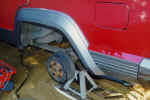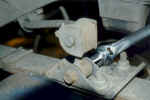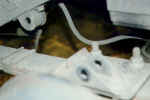Back to Jeep Cherokee
Cherokee rear anti-sway bar removal
 My first project was to permanently remove the rear anti-sway
bar. After reading a lot about modifications others had done to their XJs, it became
apparent that the rear anti-sway bar was the first change owners made. Most drivers are
looking for maximum articulation from their vehicles, and the anti-sway bars--both front
and rear--prevent just that. Removing the bar improves rear axle articulation
dramatically... for no cost. I was advised that removing it would have little effect on
the handling characteristics of the car. (Compared to the Boxster, the Cherokee is
super-squirrelly anyway.)
My first project was to permanently remove the rear anti-sway
bar. After reading a lot about modifications others had done to their XJs, it became
apparent that the rear anti-sway bar was the first change owners made. Most drivers are
looking for maximum articulation from their vehicles, and the anti-sway bars--both front
and rear--prevent just that. Removing the bar improves rear axle articulation
dramatically... for no cost. I was advised that removing it would have little effect on
the handling characteristics of the car. (Compared to the Boxster, the Cherokee is
super-squirrelly anyway.)
It's easier to remove the bar if the car is off its wheels, so I called my friend Dan.
He has a floor jack and adjustable jack stands and he's generous with his equipment to
responsible borrowers. I slid the jack under the rear differential, pumped away, then
positioned the stands under the axle. I removed the wheels with the standard Cherokee
nut-remover-thingy (see my rant on the now-replaced insanely
lame wheel nuts).
The anti-sway bar is held in place by four rubber-cushioned mounts, two on each side of
the XJ. One is attached to the bar end via a connecting rod on top of the leaf spring at
the axle junction. The other mount is a U-shaped bracket attached to the body at the
unibody frame.
 I removed the 18mm nut and bolt that secures the outer
connecting rod, both right and left, and slid the rod assembly off the end of the
anti-sway bar. Next, I removed the 15mm bolts that attach the U-shaped
bracket, both right and left. A little muscle will separate the metal U-shaped bracket
from the rubber bushing, then the already-split bushing will come off the bar.
I removed the 18mm nut and bolt that secures the outer
connecting rod, both right and left, and slid the rod assembly off the end of the
anti-sway bar. Next, I removed the 15mm bolts that attach the U-shaped
bracket, both right and left. A little muscle will separate the metal U-shaped bracket
from the rubber bushing, then the already-split bushing will come off the bar.
With all four mounts removed, the sway bar is free. There's a lot of stuff, cables,
etc., under the Cherokee, so the bar is tricky to remove. Fortunately, my brain is
enormous. Sitting on the driver's side with the wheel/tire as my seat (see what I mean
about the enormous brain?), I pushed the bar toward the other side enough for the bar to
clear the leaf spring and hand brake line and drop to the ground. Once the bar is clear of
the driver's side obstacles, the other side comes out easily.
 Someday, someone might want to restore the anti-sway bar to its
original location, so I re-bolted the U-shaped brackets (and bushings) to the body. This
will keep the parts from getting lost and prevent the bolt hole from getting filled with
gunk.
Someday, someone might want to restore the anti-sway bar to its
original location, so I re-bolted the U-shaped brackets (and bushings) to the body. This
will keep the parts from getting lost and prevent the bolt hole from getting filled with
gunk.
Reattach the wheels and lower the car. Slide the connecting rods back onto the
anti-sway bar (so they won't get lost) and put the bar in a dark corner of your garage
where Mrs. He-Won't-Stop-Talking-About-His-Jeep-Cherokee won't trip over it.
Wash your hands. You're done.
Industry Figure | Berkeley | Back to Jeep Cherokee
 My first project was to permanently remove the rear anti-sway
bar. After reading a lot about modifications others had done to their XJs, it became
apparent that the rear anti-sway bar was the first change owners made. Most drivers are
looking for maximum articulation from their vehicles, and the anti-sway bars--both front
and rear--prevent just that. Removing the bar improves rear axle articulation
dramatically... for no cost. I was advised that removing it would have little effect on
the handling characteristics of the car. (Compared to the Boxster, the Cherokee is
super-squirrelly anyway.)
My first project was to permanently remove the rear anti-sway
bar. After reading a lot about modifications others had done to their XJs, it became
apparent that the rear anti-sway bar was the first change owners made. Most drivers are
looking for maximum articulation from their vehicles, and the anti-sway bars--both front
and rear--prevent just that. Removing the bar improves rear axle articulation
dramatically... for no cost. I was advised that removing it would have little effect on
the handling characteristics of the car. (Compared to the Boxster, the Cherokee is
super-squirrelly anyway.)
